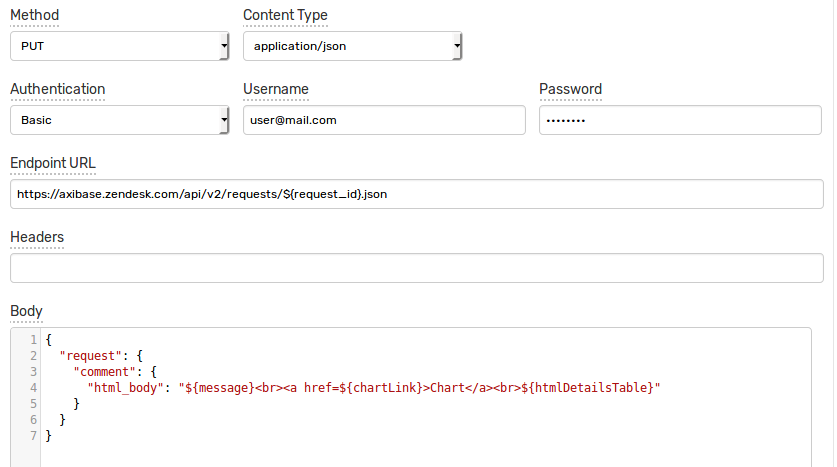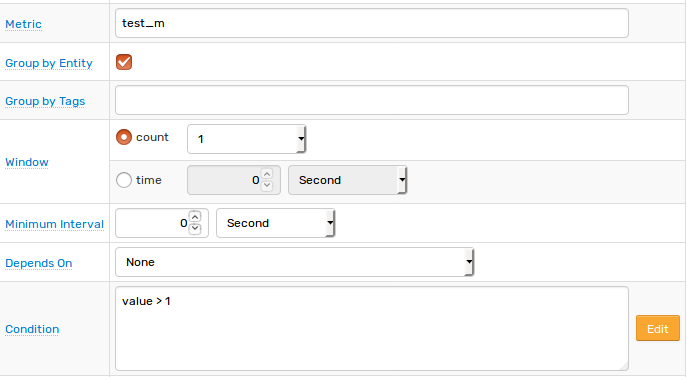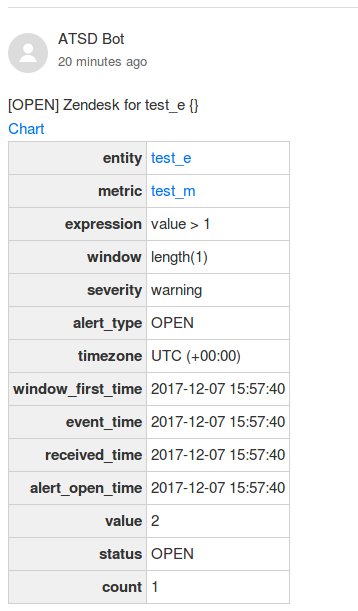Zendesk Integration
Overview
The following example demonstrates how to add a comment to an existing request / ticket in Zendesk using a CUSTOM webhook in the ATSD rule engine.
This integration relies on the Zendesk API update-request method.
Configuration
Create a new CUSTOM webhook or import the template used in this example. To import an XML template file, open the Alerts > Outgoing Webhooks page, select Import in the split-button located below the table and complete the upload form.
To create a new notification, open the Alerts > Outgoing Webhooks page and click Create.
Parameters
Enter a name and specify the following parameters:
| Name | Value |
|---|---|
| Method | PUT |
| Content Type | application/json |
| Authentication | Basic |
| Username | <ZENDESK_USER> |
| Password | <ZENDESK_PASSWORD> |
| Endpoint URL | https://<COMPANY_NAME>.zendesk.com/api/v2/requests/${request_id}.json |
Modify the Endpoint URL by replacing the <COMPANY_NAME> field with your Zendesk subdomain.
Example Endpoint URL: https://axibase.zendesk.com/api/v2/requests/${request_id}.json
the ${request_id} placeholder in the URL path to ensure that the request id is customizable in the rule editor. This allows you to add comments to different requests using the same webhook.
Enter the Zendesk user name into the Username field and the password into the Password field.
Payload
Enter the following text into the Body field:
{
"request": {
"comment": {
"html_body": "${message}<br><a href=${chartLink}>Chart</a><br>${htmlDetailsTable}"
}
}
}
The html_body text contains placeholders that are substituted with actual values when the webhook is triggered.
Placeholders specified in the payload and the URL are visible as editable parameters in the rule editor.

Rule
Create a new rule or import the rule template used in this example. To import the XML template file, open the Alerts > Rules page, select Import in the split-button located below the table and complete the upload form.
To create a new rule, open the Alerts > Rules page and click Create.
Specify the key settings on the Overview tab.
| Name | Value |
|---|---|
| Status | Enabled |
| Metric | test_m |
| Condition | value > 1 |

Open the Webhooks tab.
Set Enabled to Yes and choose the previously created webhook from the Endpoint drop-down.
Enable Open, Repeat and Cancel triggers. Set the Repeat Interval to All.
Specify the Zendesk request identifier into the request_id parameter for all triggers. The request must already exist in the Zendesk system for the entry to be valid.
To override the default message parameter which is set to [${status}] ${rule} for ${entity} ${tags}, enter a new value, for example [${status}] ${rule} for ${entity} ${tags}Duration: ${alert_duration_interval}.

The request ID placeholder in the request URL as well as payload placeholders are automatically resolved when the webhook is triggered.
https://axibase.zendesk.com/api/v2/requests/1.json
{
"request": {
"comment": {
"html_body": "[OPEN] Zendesk for test_e {}<br><a href="chart link">Chart</a><br><table>... alert table</table>"
}
}
}
Test
Test the integration by submitting a sample series command on the Data > Data Entry page.
series e:test_e m:test_m=2

The value causes the condition to evaluate to true, which in turn triggers the notification.
To verify that an alert is raised, open Alerts > Open Alerts and check that an alert for the test_m metric is present in the Alerts table.
Check the Zendesk request to ensure the new comment is added.

